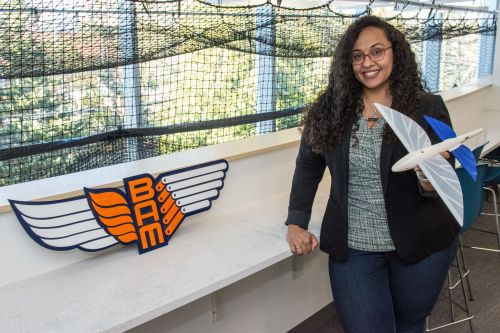
When Aimy Wissa was six years old, she became fascinated by the mechanics of airplanes. She wanted to know how they worked and how to fix them. When she moved from Egypt to New Jersey at age 16, she was determined to study aerospace engineering.
While earning her bachelor’s degree in aerospace engineering, she was introduced to the world of research through the McNair Scholars Program and began to work on developing technologies for nondestructive evaluation of aircraft. At the time, she thought she wanted to pursue her graduate school research in the same field.
But when she met the professor at the University of Maryland who would become her advisor, he invited her to join his lab, but for a project focused on bird-inspired flight.
“That's how I got really excited about birds, biology, and the intersection of biology and engineering,” Professor Wissa says. “I spent months looking at birds, birds’ flight, and studying articles about avian morphology and flight.”
And, so, she launched her academic career in bio-inspired design, an engineering approach informed by natural systems that have evolved in agility and adaptiveness and largely remain unmatched by the most advanced machines and technologies.
Appointed in January 2022 as an assistant professor in the Department of Mechanical and Aerospace Engineering at Princeton University, Professor Wissa brings a wealth of experience and knowledge in bioinspiration and bioinspired locomotion from the research program she developed at the University of Illinois Urbana-Champaign.
In both teaching and research, she collaborates with ornithologists and entomologists to design, model, and build adaptive structures and systems for robotic and aerospace applications.
“What’s interesting about my field is how interdisciplinary it is,” she says. “The idea of interdisciplinary teams coming together to improve engineering systems based on biological solutions or to test biological hypotheses using engineering analyses and models is truly fascinating to me.”
She began her research studying bird wings to address problems of limited agility and maneuverability in unmanned aerial vehicles, or drones. Previous research on bird-inspired flight focused on the flapping mechanism of the wing. But Professor Wissa noticed that birds—particularly large ones like eagles, and owls—don’t flap their wings most of the time because this takes extraordinary amounts of energy. Instead, small local shape changes at the feather level take place to adjust and adapt to airflow.
“That was the ‘aha’ moment for me,” she says. “Rather than thinking about flapping or making large changes, I began to ask, “How can we design small local shape changes inspired by the intricate function of feathers to design flow control systems for our engineered aerial vehicles?”
Professor Wissa first zoned in on covert feathers, which cover other feathers on the wings and tail. She found lots of studies that described the shape of these feathers, what they are made of, and some of their properties, but there wasn’t much known about their function. She found that birds use covert feathers to correct for flow reversal over their wings during high-angle-of-attack maneuvers and in strong gusts of winds, preventing the birds from stalling midflight.
She was recognized for her work with Young Investigator Award from the Air Force Office of Scientific Research in 2018. As part of this effort, Wissa and her team are designing covert-inspired deployable structures on the upper and lower surfaces of a wing.
Professor Wissa’s research has expanded to look at many other animals as well, especially insects. For example, she is leading pioneering research in click beetles. Her team has found the amazing capability of these beetles to propel themselves more than 20 times their own height into the air without using their legs. Sometimes beetles use this jump to flip themselves over if they have fallen on their backs on landing.
Beetles accomplish this by transferring energy from muscles into a spring, which is held in place by a mechanical latch in the beetle’s thoracic region. The release of the latch results in a fast recoil. Professor Wissa’s team is working on transferring this principle into engineering prototypes, such as agile robots that probe inhospitable areas or uneven terrain, such as inside pipes or on planets.
“The idea is that if these robotic devices fall over, they will be able to self-correct their orientation and continue on their mission,” says Professor Wissa, who was awarded a Faculty Early Career Development grant from the National Science Foundation in 2021 to continue her research in this area.
Grasshoppers and flying fish are among other animals that are inspiring her research. At Princeton this year, she introduced a bio-inspired design class where engineering and biology students work together to design and develop engineering solutions that are inspired by nature.
“I want students to observe and decompose clever solutions in nature, like how an octopus can grip underwater,” she says, “and how we can transfer this principle into engineering solutions.”